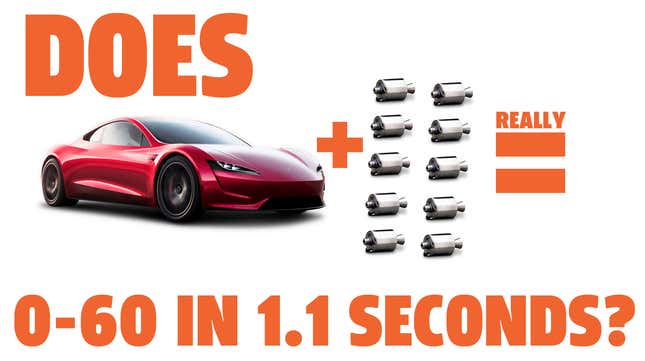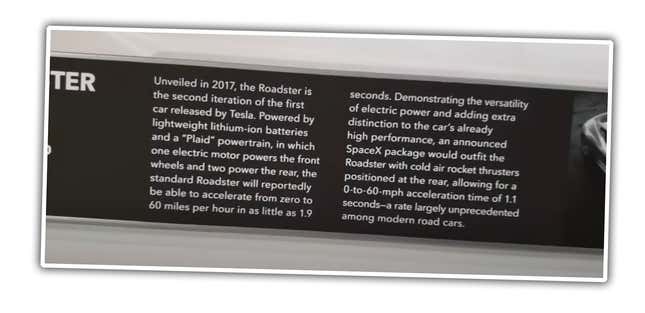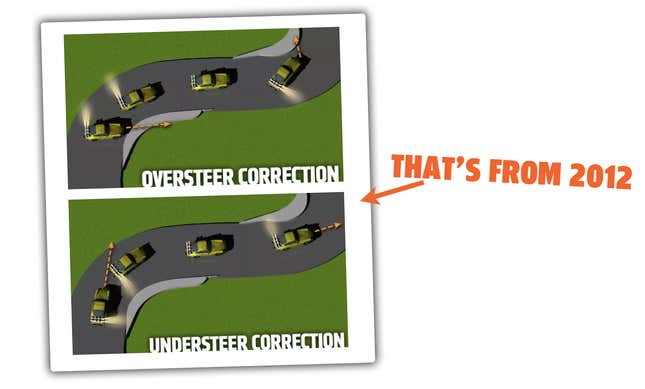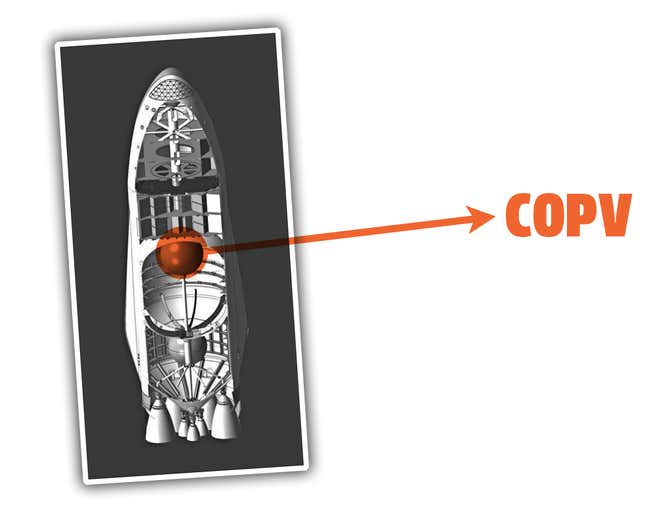
Ever since Tesla announced that it’s developing an all-new Roadster, there have been remarkable claims made about its potential for speed. First there’s the claim of getting from zero to 60 mph in 1.9 seconds, which we scrutinized more than once, and now there’s the claim that with a set of cold-gas thrusters known as the “Space X Package,” the roadster could hit a mile-a-minute in an absurd 1.1 seconds. This is a bonkers number to consider, so I reached out to a physicist to run the numbers.

Before we get into the analysis, a little more background is in order, I think. Previous assessments of the 1.9 0-60 claim seemed to bear out that it should be possible, as there are rallycross cars that can hit those numbers, and from a battery/motor/power standpoint, it’s do-able.
Tires are a bit of a question, though. Those rallycross cars use special tires, as does everything that can accelerate that fast, or faster, like top-fuel drag cars. The best performance modern street tires might be able to do under two-second 0-60 times, but the truth is that we’re not really certain.
Yes, Tesla claims that their Model S Plaid can hit 0-60 in 1.9 seconds, but they’re not really being entirely honest there, as Jason Fenske explains in this excellent and detailed Engineering Explained video:
Essentially, Tesla is subtracting the first foot of rollout, which means that it’s not really going from 0-60 at all, which is a drag racing conceit. Doing the math, it’s more like a 6 mph to 60 mph speed, which isn’t the same at all. If you don’t believe me, stand still and try to catch a dog running away from you at 6 mph.
Factoring in the rollout, the Model S Plaid has a 0-60 time of over 2 seconds. Still fast, absolutely, but within the grip limits of modern tires.
Maybe the Roadster will have some tires capable of hitting 1.9 seconds to 60, maybe not. We’ll have to see. To get to 1.1 seconds to 60, though, Tesla is planning something far more exotic, the Space X Package, which is essentially rocket-like engines on the car.
Now, just for the record, this is not something that Elon was the first to dream up; the idea of rocket thrusters on non-rockets isn’t exactly new. Bosch demonstrated a thruster-assist for motorcycles in 2018, and I myself proposed the idea back in 2012, though both of these concepts were more about using them as reaction control thrusters to improve safety and handling and not just a speed boost, like the Tesla.

What Tesla is thinking of for the roadster is described in this tweet from Elon somebody:
Further clarification followed from Musk:
We are going use ultra high pressure compressed air — it’s a cold gas thruster. The main thruster will be like behind the license plate so for acceleration, it drops the license plate and behind the license plate is a rocket thruster.
Okay, so a compressed-air thruster system. So how possible is this? What would it actually take to work? Since these questions involve a lot of math, and my doctor told me if I do too much math I’ll sprain my already weakened brain so much I’ll have to limit my thoughts to just imagining various floating sandwiches or remembering old Marmaduke comics, I’m going to pass this off to Jalopnik’s captive and relatively tame physicist, Dr. Stephen Granade.
Take it away, Stephen:
Okay, numbers checked, errors fixed, and I still think it’s possible but impractical. Here’s the full details:
Could you stick a bunch of SpaceX cold gas rocket thrusters around a Tesla Roadster and get a blistering 0-60 MPH time of 1.1 seconds? That’s less than half the best time I know of, so you’re talking about a remarkable claim. Is it even possible?
The short answer is, “maybe, but it’s likely not practical.” The longer answer involves math and some estimations.
Rockets work thanks to Newton’s third law of motion: for every action, there’s an equal and opposite reaction. A rocket throws stuff backwards to push itself, and whatever it’s bolted to, forward. That’s thrust. Rockets like SpaceX’s Falcon 9 burn gas to produce thrust because high temperatures and pressures give you the most bang for your buck. But you don’t have to burn fuel to produce thrust. Think about blowing up a balloon and releasing it. The air inside rushes out of the little opening and makes it fly around. Cold air thrusters work on the same principle. They’re not as effective, but a car with flames shooting out behind it might not be street legal.
How effective are cold air thrusters, though? The rocket equivalent of fuel efficiency is called “specific impulse”. The higher a rocket engine’s specific impulse, the more efficient it is. Specific impulse is measured in seconds, which sounds weird until you realize that specific impulse is the answer to the question, “How many seconds can a specific engine, using a specific fuel, accelerate its own mass at one g?” The Falcon 9's first stage uses engines with a specific impulse of 280 seconds at sea level.
A cold air thruster using air? Since air’s mostly nitrogen, I’ll use the specific impulse for a nitrogen thruster: about 70 seconds.
That’s...not very fuel efficient. But is it enough? To figure that out, we need to see how much thrust we need and, based on that, how much air the thrusters will use up pushing the car with that amount of thrust.
Another word for “thrust” is “force”, and force is equal to mass times acceleration. I’ll assume the Roadster speeds up at a constant acceleration, which probably isn’t true but is close enough for my purposes. To get to 60 MPH in 1.1 seconds, the car needs an acceleration of a touch over 24 meters per second squared, or nearly 2.5 g. Going back to high school physics, we know that the force required will be that acceleration times the car’s mass. The battery pack may be around 800 kg, so I’ll assume that the car will be around 1600 kg. That means the car needs nearly 39,000 newtons of thrust to reach that speed.
However, the thrusters aren’t the only thing pushing the car. The wheels and powertrain can supposedly get the car to 60 MPH in 2.1 seconds. To do that, they must provide around 20,000 newtons of force. Assuming the thrusters don’t make the tires lose their grip, that leaves 19,000 newtons of force for the thrusters to provide.
A rocket’s thrust equals its specific impulse times g times how fast the rocket engine expels mass. To produce the amount of thrust we need, the thruster has to throw out nearly 27 kilograms of air every second. The Roadster will supposedly use 10 thrusters instead of just one, but that just means that each thruster will throw out 2.7 kilograms of air each second. The total required air per second stays the same.
(By the way, the air will come out of the thrusters at some 1,500 mph. Don’t change lanes too close in front of another car when you’re firing those thrusters!)
If you’re only going to use the thrusters to get to 60 MPH over the 1.1 seconds, you’ll need 30 kg of air. At normal air pressure, you’d need a tank the size of a shipping container. But Tesla is using compressed air stored in a SpaceX pressurized vessel, known as a COPV. The SpaceX COPVs hold nitrogen at 6,000 psi. At that pressure, you can get the air you need into a 55 liter container.

55 liters is equivalent to 15 gallons. That’s not bad! A COPV the size of a small home water heater would hold that much. Tesla plans on taking out the two back seats to make room for the COPV (), which I estimate would leave room for about 140-150 L tank.
However, being in the neighborhood of plausible isn’t the same thing as being practical. The pressure inside the COPV will drop as air goes out of the thruster, so you’d want more than 55 L of air. Worse, though, will be refilling the tanks. Tesla has suggested that they’ll use an electric pump to re-fill the tanks:
The trick is to find a portable electric air compressor that can refill the tanks to their pressure of 6,000 psi. Worse, the higher the output pressure, the slower it fills a tank. You find these high pressures in SCUBA tanks, so I too a look at SCUBA tank air compressors. HPDMC makes one that has a working pressure of 4,500 psi. It would take two and a half hours to fill our 55 L tank. It also sucks down 3,000 watts. That’s a lot of power, but you could swap it out with one from BEAMNOVA or Orion. They only use 1,800 watts. Of course, now it would take four hours to refill the tank.
I think you’re looking at a one-shot acceleration system that would take ages to recharge. Being in the Roadster when the thrusters fire off would be a heck of an experience, but not one you’d do more than twice a day. Maybe Tesla will add big compressed air tanks to their Supercharger stations.
Okay, so according to Dr.Granade, it looks like the verdict is that this could be technically possible, but with some pretty significant caveats: you’ll have to be driving around with a big-ass 6,000 psi compressed air tank right behind your seats, and if you decide to use your 0-60 in 1.1 second red mushroom super turbo boost, it’s a one-shot deal until you use a big chunk of your available battery (between 7.2 kWh to 7.5 kWh) and between two and a half to four hours to re-fill the compressed air tank.
And all of that is assuming that the thrust won’t exceed the grip of your tires or the surface you’re on or any number of other variables here. Plus, I haven’t heard anything about what sort of safeguards will be in place to prevent morons from launching their Roadsters into walls or over cliffs or into lovely, fresh-water lakes.
Will touching the brake cut off the thrusters immediately? What about if the steering wheel angle goes past a certain point? You sure as hell wouldn’t want to kick this on with that wheel cranked even a few degrees off of dead straight ahead, as that would just launch your fancy roadster into a nearly uncontrollable death spiral, with jets of air blasting backwards at 1,500 mph.
I’m all for using technology to make cars more fun, and while I’m sure this would be thrilling when employed, overall it seems like way too much equipment, weight, effort, risk, and uncertainty to really be worth it.
I’m sure the Tesla Roadster with the air thrusters would be a blast at the drag strip, in the same way that the Dodge Demon is, albeit in a much more exotic, high-tech way, but as far as something that adds fun to driving whenever, this isn’t it.
Maybe it could actually hit 60 in 1.1 seconds, and I’m sure for some people that thrill will be enough to carry them four hours of talking about it until they can try again, but for me, it just seems like an expensive, silly stunt.
It might make future Cars and Coffee wrecks a lot more exciting, though, so there’s that.